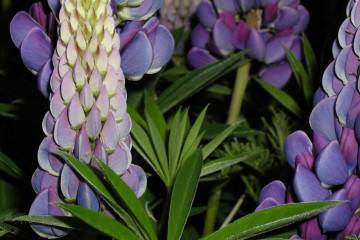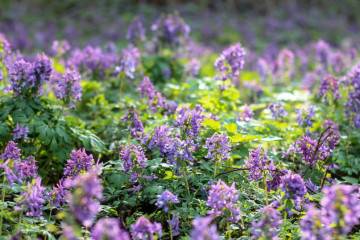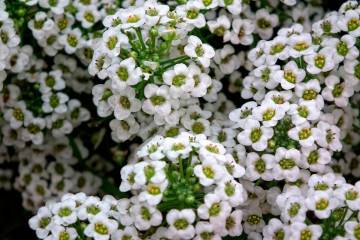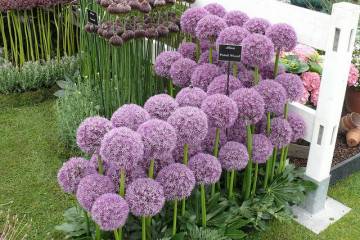Perennial lupine as a honey plant
Content:
Lupine is an amazingly beautiful flower that is sown to obtain beekeeping products. Lupine has everything for bees: an attractive appearance, aroma, nectar and a lot of pollen, 60-80% more than other melliferous plants. Separately, bees do not collect lupine honey, it is part of the flower.
Is lupine a honey plant
Disputes on this topic are still ongoing. It has been experimentally proven that lupine as a melliferous plant gives up to 70 kg of honey per hectare (on average, without taking into account the characteristics of the variety). The flower is bred for the sake of a large amount of pollen, sown next to other flower crops.

The plantings of several varieties of lupins look picturesque, amaze with a riot of colors, the correct shape of the sultans
Scientists have not yet made a final conclusion about whether lupine is a honey plant or not, so each of the beekeepers decides on his own. It can be argued that insects collect honey from it, but the honey productivity of lupine is low in comparison with other melliferous plants. The plant has no nectar glands on the stem, sepals. It releases nectar only on the pistil.
Description of the varieties of lupine melliferous, its honey productivity
The Latin word "Lupus" is translated "wolf". The flower is called wolf beans in some countries. The botanical name for the flower is "Lupinus".
This is a plant of the dicotyledonous family, from the legume genus. This is a perennial shrub or semi-shrub with spreading round leaves, whorled flowers, collected in long sultans of inflorescences. Bush roots, up to 2 meters long, form nitrogen-containing nodules, leaves synthesize it from the air.
The petals range from milky white to deep purple. Stems are erect, herbaceous or lignified. The fruit is pubescent, elongated. The leaves are leathery, when they dry, they spontaneously open, the seeds in the form of a bean spill out onto the ground. In nature, the plant reproduces by self-seeding. You can also determine whether lupine is a honey plant or not by its appearance. Productivity varies greatly among species.
Yellow
The bush grows naturally in Polesie, blooms from June to cold weather, forms thick inflorescences of medium height. Cold-resistant, it takes root well on sandstones, peat soil with a slightly acidic pH-reaction. The source of pollen, sometimes pollen and bee bread, accounts for up to 25% of winter bee stocks. The pollen is bright orange, sticky, clumps together.
White
The variety is thermophilic, drought-resistant. Found in Ukraine. Stretches up to 2 meters. The White Sultan lasts up to 30 days. Sultans are wide, medium-sized or long, depending on the region of growth. In the conditions of the middle zone, it is used as an annual green manure or a source of feed.
Narrow-leaved
This lupine belongs to the melliferous, it grows in color: pink-white, blue, dark purple. The color intensity depends on the composition of the soil. The most productive variety in terms of melliferousness, average in the collection of pollen and bee bread.

Wild thickets of narrow-leaved lupine are visited not only by bees, but also by bumblebees. Flowering period up to 30 days
Features of lupine as a honey plant: useful properties of such honey
Lupine flowers are unattractive for honeybees. Bees always mix lupine nectar with sweetness collected from other plants. The honey turns out to be polyfloral. Lupine contains the alkaloid lupinine, it is present in bee delicacies and pollen.The pollen of flowers is reddish-brick, valued for its complex chemical composition.
During the growing season, bees collect up to 10 kg per hectare from narrow-leaved blue and purple varieties, from other varieties - less, but not less than 5 kg. Beekeeping products with lupinine are used mainly externally for ointments and lotions in the treatment of:
- ulcers;
- deep cuts;
- suppurating wounds;
- abscesses;
- acne;
- joint inflammation.
The alkaloid lupinine has a healing, mild analgesic and antispasmodic effect. Relieves swelling, redness, disinfects the dermis.
How to grow honey lupine for maximum honey production
It is better to sow a culture together with phacelia - an annual of the family of water-leaved plants, rich in nectar. The honey is aromatic and healthy. Seeds are sown at different times:
- before winter, planting material is buried in frozen soil to a depth of 2-2.5 cm. Top covered with dry humus or peat with a layer of 1 cm. Crops will give flowers the next year, germinate in early spring immediately after the snow melts;
- the seeds are sown when the soil warms up to + 10 ° C. Seedlings begin to thin out after the appearance of the 3rd true leaf. Lupine will bloom only after a year, in the first year it is cut for silage;
- with the seedling method, sowing is carried out in greenhouses or planting containers for keeping in apartments. Lupine sowing dates are April. Before planting in the ground, they are left on the street for two days. After 35 days of growth, seedlings are planted in a permanent place.

This is how lupine seeds look like, these are small beans of a creamy or yellowish hue. Before planting, it is advisable to soak them for swelling.
The plant takes root on any kind of soil, but slightly alkaline or neutral is recommended for the formation of long sultans. The optimal distance between the bushes is 30-50 cm.
Shallow pits are made before planting. Lupine is transplanted by the transshipment method without damaging the earthen coma.
High peduncles in blown-out places are tied to a support, trellises are installed near the plantings. Fading sultans break out to stimulate the formation of new ones.
For seed, darkened beans that did not have time to burst are collected. Ripening of seeds occurs in September-October, depending on the weather. The first inflorescences are removed before fruiting.

Insects visit the flowers of the lower rows more often, whorls of the upper part of the inflorescence are less interested in them
Although lupine cannot boast of special honey productivity, it is valuable for beekeeping as a source of pollen - pollen carried on the abdomen and legs of insects. Bees, bumblebees fly up to flower sultans in the morning, afternoon and evening. Lupine is grown as a honey plant with other, more productive plants.

















